Chakratirtha, which can be roughly translated as ‘sacred whirlpool,’ is a significant site located between the Rishimukha Hill to the north and the Matanga Hill to the south in Hampi. Situated near the Kodanda Rama Temple, Chakratirtha holds both religious and natural importance. It is a place where the Tungabhadra River narrows and changes its direction, creating strong currents and a whirlpool-like effect. This sacred spot attracts pilgrims and visitors, particularly on auspicious days, and is believed to have mythical and divine associations.
It is situated along the banks of the River Tungabhadra, approximately 650 meters away from the Hampi Bus Stand. You will come across this area during your Riverside trek from the end of Hampi Bazaar towards Vittala Temple along the Riverside Ruins.
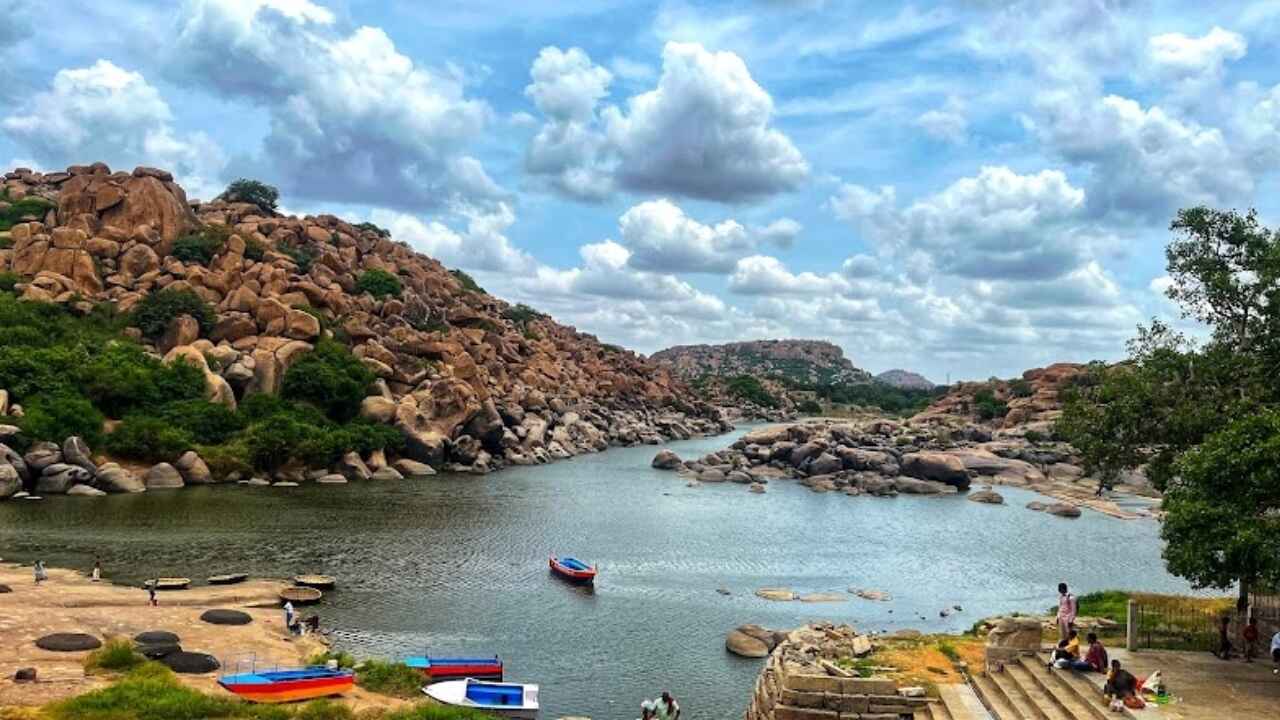
Table of Contents:-
Chakratirtha, with its sacred whirlpool and divine associations, offers a unique and spiritually significant experience for visitors. The ritual bathing, the nearby Kodanda Rama Temple, and the mesmerizing rock carvings contribute to the religious ambiance of the place. While caution and respect for safety are essential due to the strong currents, the serene exploration and coracle rides provide glimpses of the natural beauty that envelops Chakratirtha. It is a place where mythology, spirituality, and the scenic allure of the Tungabhadra River converge, leaving a lasting impression on all who visit.
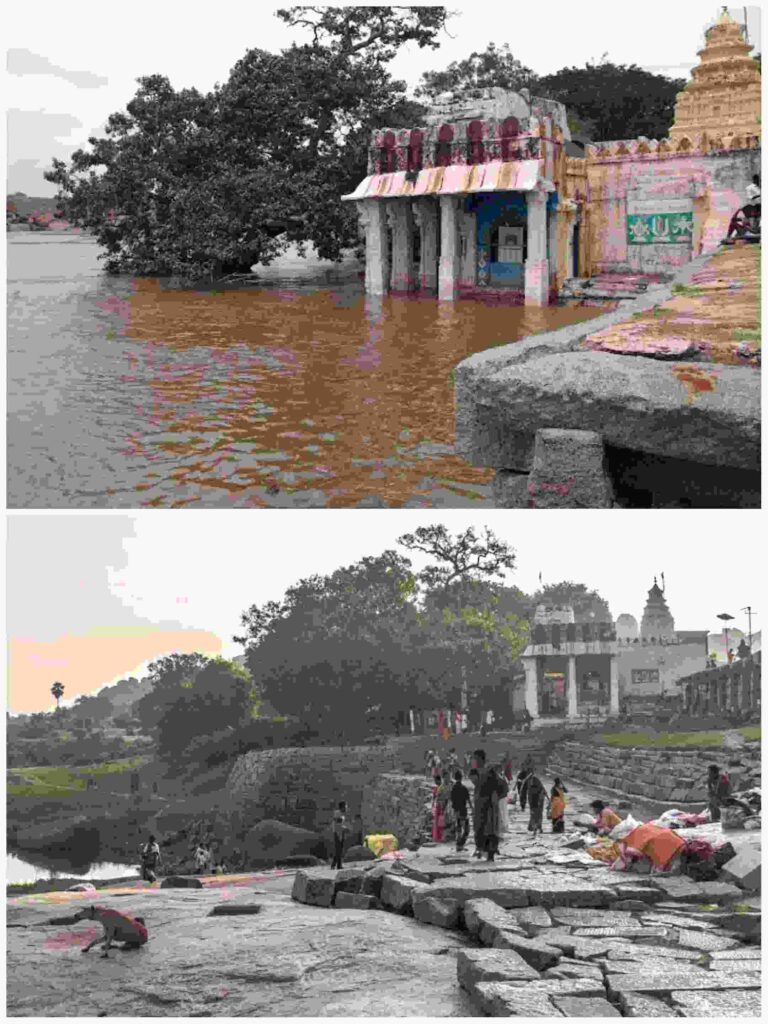
Quick Facts
- Timing: Daylight Hours Only
- Entry Fee: No entry fee required
- Photography: Allowed
- Location: Google Maps
- Must-See Attractions
Legends and spiritual importance
Chakratirtha is considered one of the most sacred places along the course of the Tungabhadra River. According to local legends, it is believed to be the spot where Lord Shiva handed Lord Vishnu his weapon, the Chakra. The swirling waters at Chakratirtha are said to embody this divine exchange. Additionally, there are stories that suggest the patterns formed by the swirling waters resemble images of Lord Rama, Sita, and Lakshmana, adding to the spiritual allure of the place.[1]
Pilgrims often take a holy bath in the waters of Chakratirtha before visiting the nearby Kodanda Rama Temple. The belief is that the purifying waters of the river cleanse the devotees’ sins and prepare them for a spiritual experience. Adjacent to the temple, there are ancient pavilions that have provided resting places for pilgrims for centuries. After the ritual bath, many pilgrims also make it a point to visit the Yantrodhara Anjaneya Temple, seeking blessings and further spiritual solace.
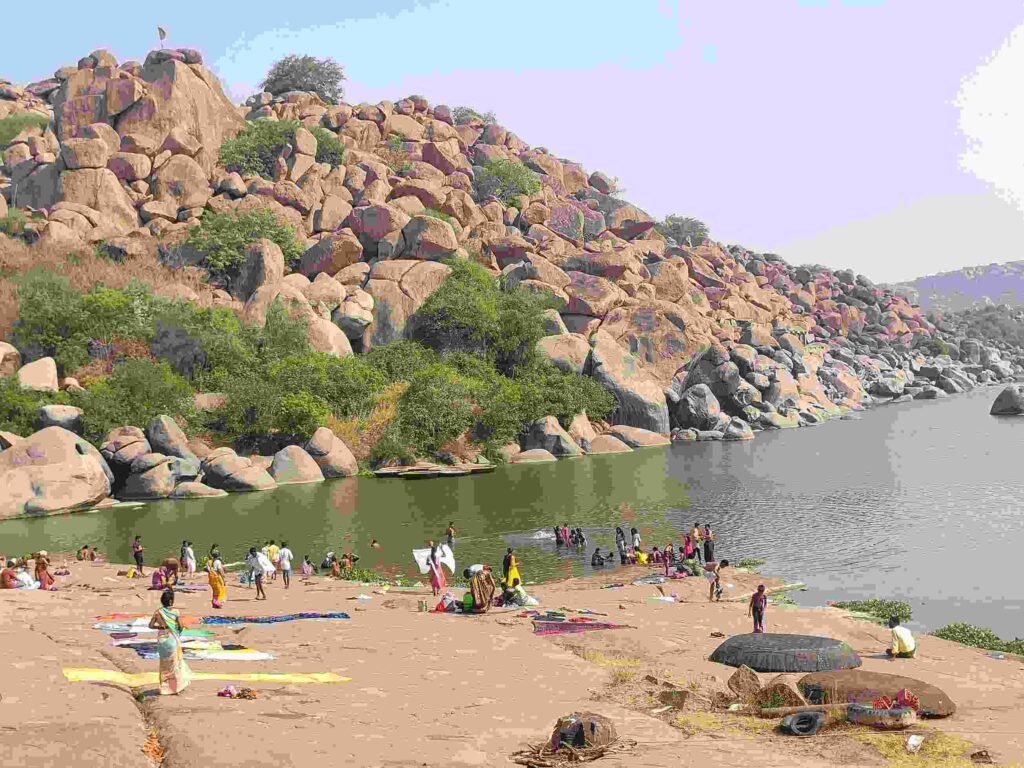
Kodandarama Temple
This temple is dedicated to Kodanda Rama and is located on the right bank of the Tungabhadra river, near Chakrathirtha. It is built around a large boulder adorned with carvings of Rama, Sita, Lakshmana, and Hanuman. In the central depiction, Rama stands holding a bow and arrow, with Hanuman next to Lakshmana and Sita standing to Rama’s left. According to local stories, this temple marks the spot where Laxmana crowned Sugriva after Vali was killed,[2] signifying its historical and mythological significance.
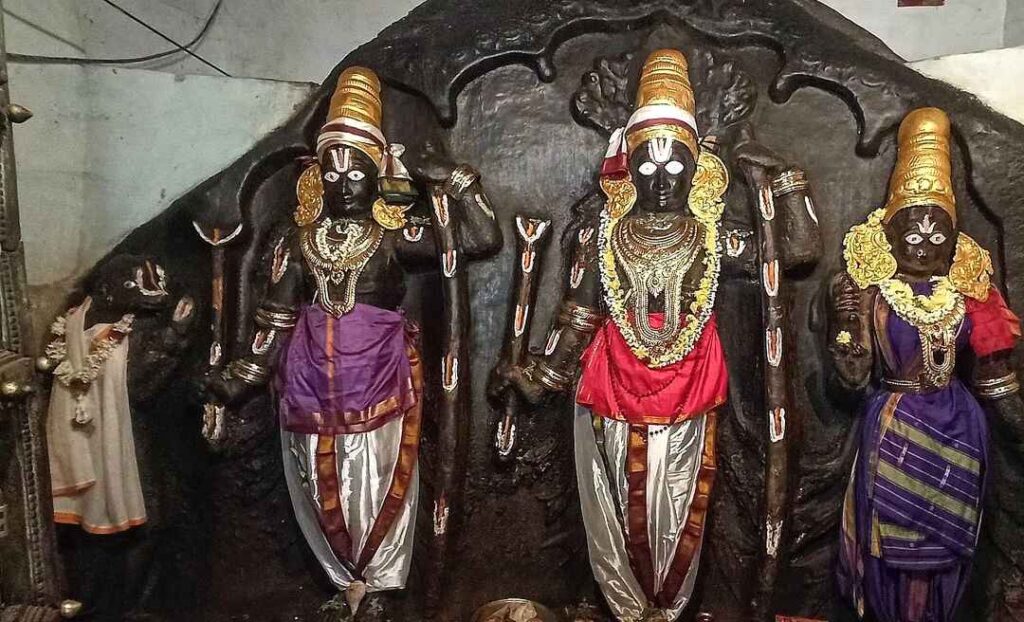
Kodandarama is another name for Lord Rama, the seventh avatar of the Hindu god Vishnu. The name “Kodandarama” refers to Rama holding a bow (“kodanda” means bow). It signifies Rama’s role as a warrior prince who wielded his bow to defeat evil forces and uphold righteousness.
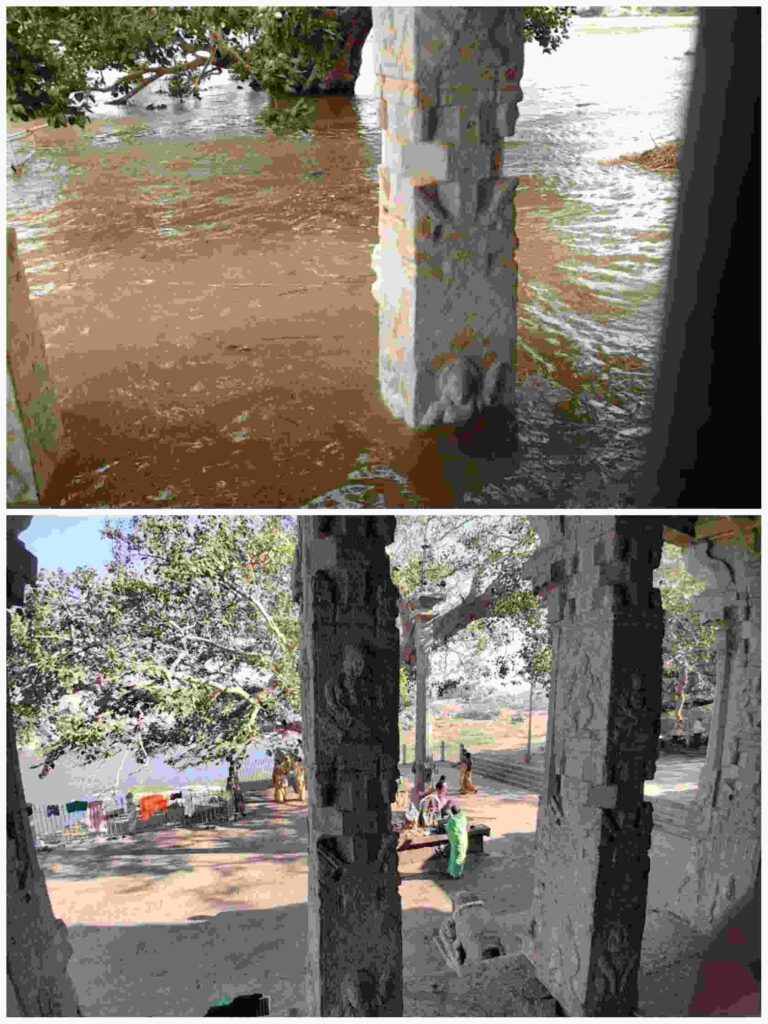
Religious Carvings and Rock Significance
At the riverbank of Chakratirtha, a large flat rock faces the Kodanda Rama Temple. This rock holds immense religious significance for devotees and pilgrims, serving as a focal point for spiritual contemplation and worship.
The rock is adorned with a myriad of intricate carvings, each carrying its own symbolic meaning. Among these carvings are Shiva Lingas, representing the divine energy of Lord Shiva, and footprints arranged in circular patterns, believed to be those of the gods themselves. These carvings not only showcase the artistic prowess of the craftsmen but also add to the mystical and sacred atmosphere of the site, inspiring reverence and awe among visitors.
Devotees often gather around the rock to offer prayers and perform rituals, seeking blessings and guidance from the divine. The serene backdrop of the flowing Tungabhadra River enhances the spiritual experience, allowing visitors to connect with the ancient traditions and beliefs that have been passed down through generations.
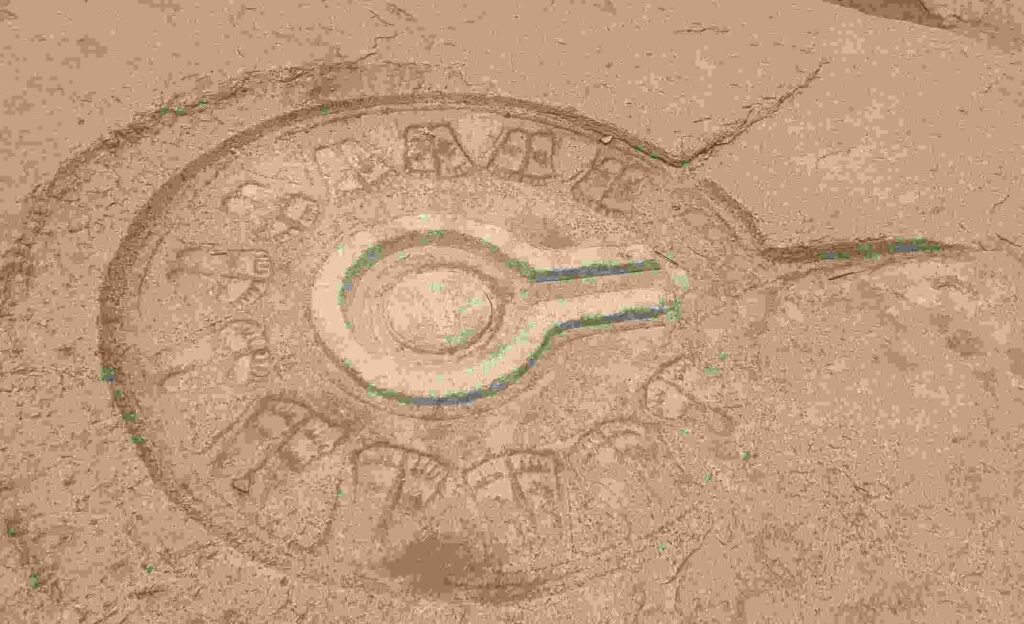
Ancient Pavilions at Chakratirtha
The presence of several ancient pavilions next to the temple complex speaks volumes about the enduring importance of Chakratirtha. These structures, built centuries ago, have served as resting places for countless pilgrims on their spiritual journeys. These ancient pavilions, with their weathered stone walls and intricate carvings, offer a sanctuary for weary travelers seeking respite from their arduous journeys.
Situated amidst the serene surroundings of Chakratirtha, they provide a quiet space for pilgrims to rest and reflect on their spiritual experiences. For generations, pilgrims have sought refuge in these pavilions, taking moments of rest to recharge their spirits and offer prayers to the divine. The echoes of their chants and hymns linger in the air, creating an atmosphere of reverence and tranquility that permeates the sacred site.
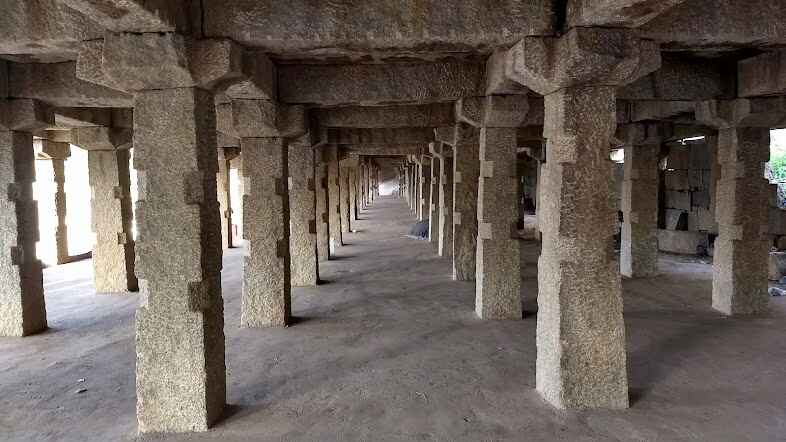
The presence of ancient pavilions next to the temple complex at Chakratirtha serves as a poignant reminder of the enduring importance of this sacred site. As pilgrims and visitors alike seek solace and spiritual renewal, these structures stand as silent guardians, offering shelter and sanctuary to all who journey to this hallowed place.
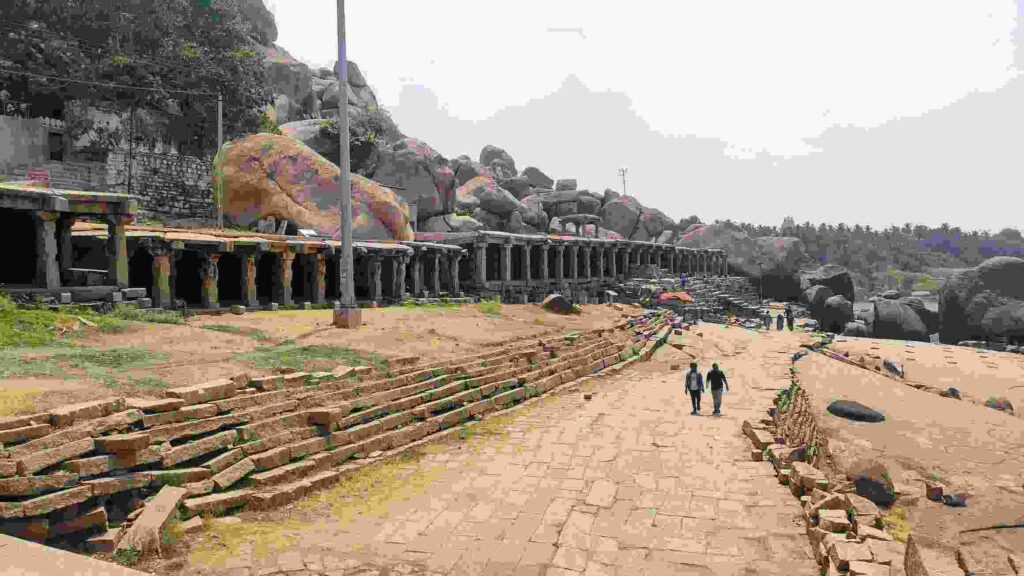
Kampabhupa Pathway
In Hampi, the capital of the Vijayanagara Empire, many ancient paths were built by the rulers. One of the most important of these ancient routes is the Kampabhupa Pathway. This broad stone pathway runs along the banks of the Tungabhadra River and is said to have been laid on the orders of Kampabhupa, the son of Vira Harihara Raya (1377 – 1404 CE).[3]
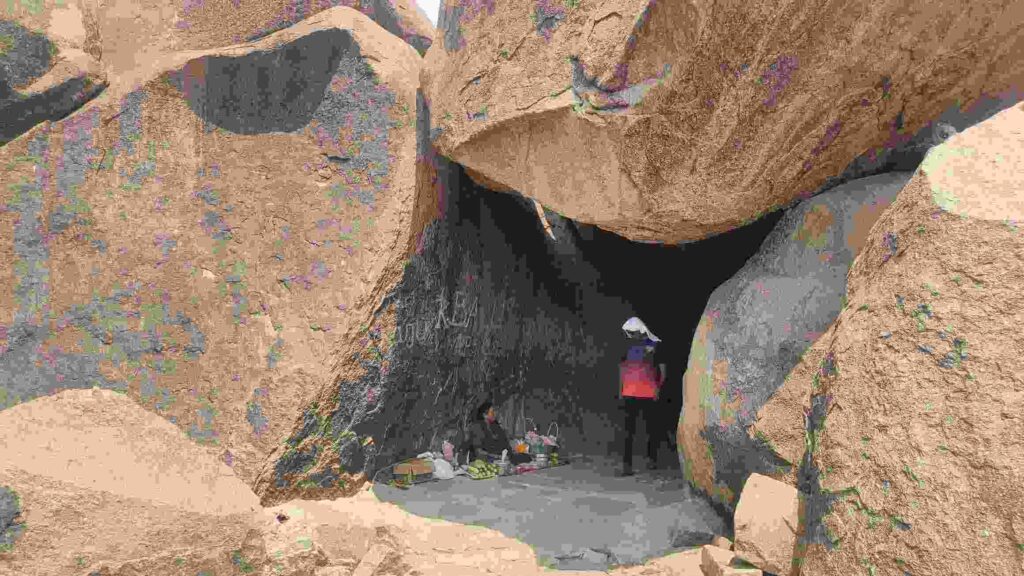
The Kampabhupa Pathway connects the Virupaksha Bazaar Street to Chakratirtha and beyond, leading towards the double-storeyed gateway of Vittalapura. Starting at the eastern end of the Virupaksha bazaar, the pathway passes through a narrow passage between a group of boulders, also known as the “Onake Kindi” or “window view.”
A bas relief sculpture of a standing male figure with folded hands in Anjali mudra is believed to be Kampabhupa, who ordered the construction of the pathway. However, when the water in the river rises, this pathway is completely submerged, adding to the mysteries and charm of Hampi’s ancient pathways.
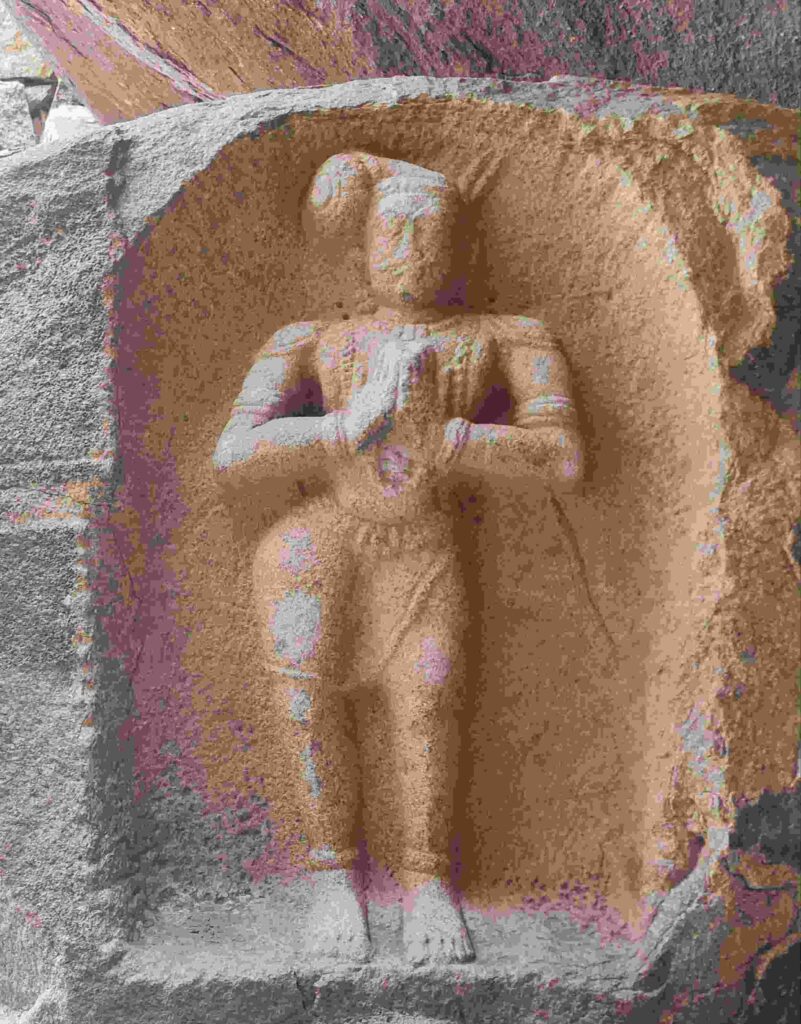
Coracle Ride at Chakratirtha: Tranquil Exploration Along the Tungabhadra River
During favorable weather conditions, visitors can enjoy coracle rides to cross the river or leisurely float along the riverbank. Coracles are traditional round boats made of woven bamboo and coated with a layer of tar. These rides provide an opportunity to appreciate the natural beauty surrounding Chakratirtha, as well as witness the tranquil flow of the Tungabhadra River.
As visitors embark on these serene journeys, they are treated to panoramic views of the lush greenery and ancient ruins that line the riverbanks. The gentle sway of the coracle and the soothing sound of water lapping against its sides create a sense of peace and tranquility, allowing guests to fully immerse themselves in the beauty of their surroundings.
Guided by skilled local boatmen, these coracle rides offer a unique perspective of Chakratirtha and its surroundings, allowing visitors to witness the sacred site from a different vantage point. Whether crossing the river to reach the temple complex or simply enjoying a leisurely ride along the water, coracle rides provide an unforgettable experience that showcases the natural and cultural wonders of Hampi.
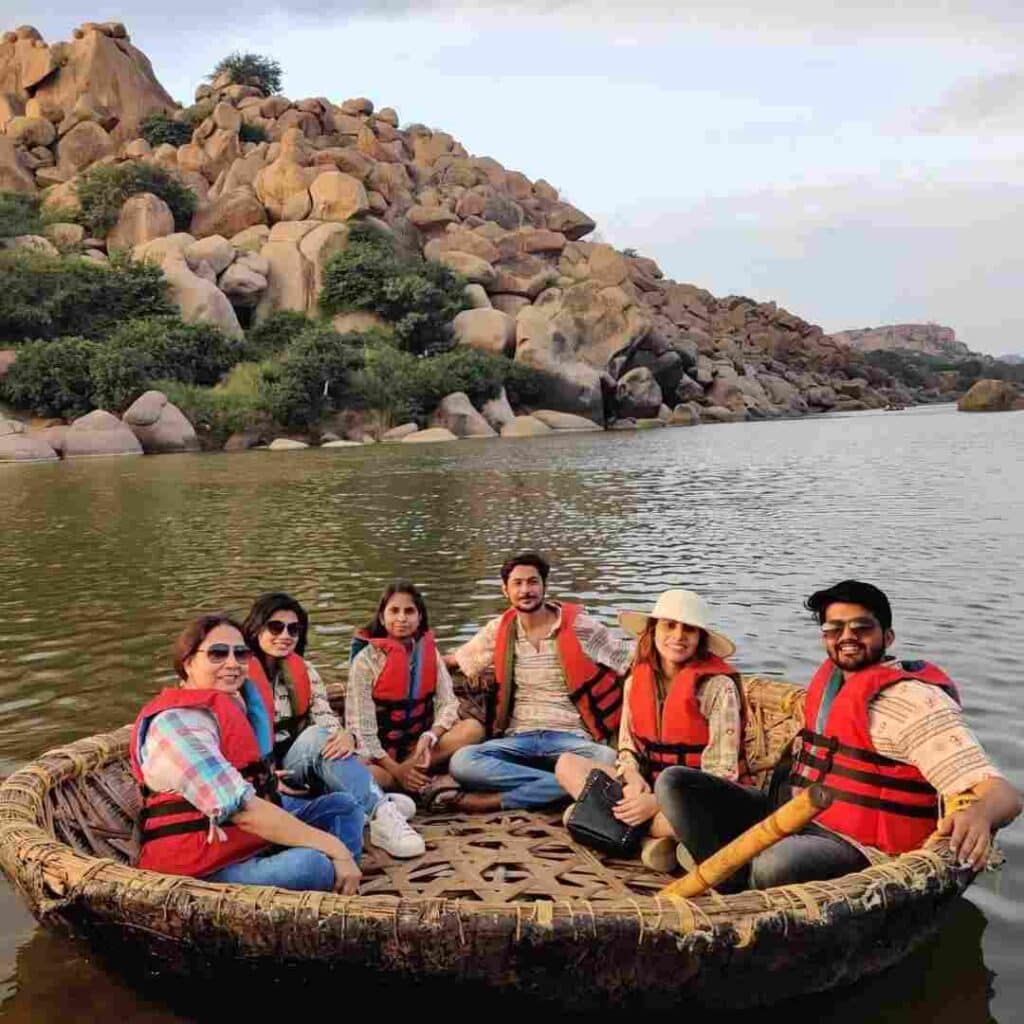
Photography at Chakratirtha
For photography lovers, Chakratirtha’s surroundings offer many beautiful scenes to capture. You can take stunning photos of the sunrise painting the swirling waters in shades of orange and pink. The carvings on the riverside rock look amazing in the golden light of the setting sun, creating interesting shadows and highlights. Chakratirtha is a great spot for photography with its colorful sunrises and sunsets, intricate carvings, and serene atmosphere.
You can also capture moments of peace, like pilgrims doing rituals or meditating by the riverbank. Their silhouettes stand out against the big sky, making for beautiful photos that show the calmness of the place.

Safety Precautions and Monsoon Season
It is important to note that swimming or playing in the water at Chakratirtha is strictly prohibited due to the strong river currents and the whirlpool effect. The safety of visitors is of utmost concern, and caution must be exercised while near the water. Visitors are advised to stay on designated paths and avoid venturing too close to the riverbank.
Additionally, it is advisable for tourists and pilgrims to avoid visiting Chakratirtha during the peak monsoon season. The water level of the Tungabhadra River can rise significantly during this time, occasionally reaching the courtyard of the Kodanda Rama temple, making it unsafe to visit. Heavy rainfall can lead to flash floods and swift currents, posing a risk to anyone near the river. It is recommended to check weather forecasts and travel advisories before planning a visit to ensure a safe and enjoyable experience.

Finding Serenity by the River: A Peaceful Moment at Chakratirtha
Sometimes, the best thing to do is just relax and enjoy the moment. Find a quiet spot by the river, take a deep breath, and listen to the sound of the water flowing. You can sit and watch the water swirl around in the whirlpool – it’s really fascinating to see!
Being in this calm and peaceful place, surrounded by history and nature, gives you a chance to feel connected to yourself and to Hampi. Take a moment to think about the beauty of the place and how lucky you are to be here.
Whether you’re alone or with friends, sitting by the river at Chakratirtha is a great way to forget about your worries and find some inner peace. So take your time, relax, and enjoy the tranquility of this special spot.
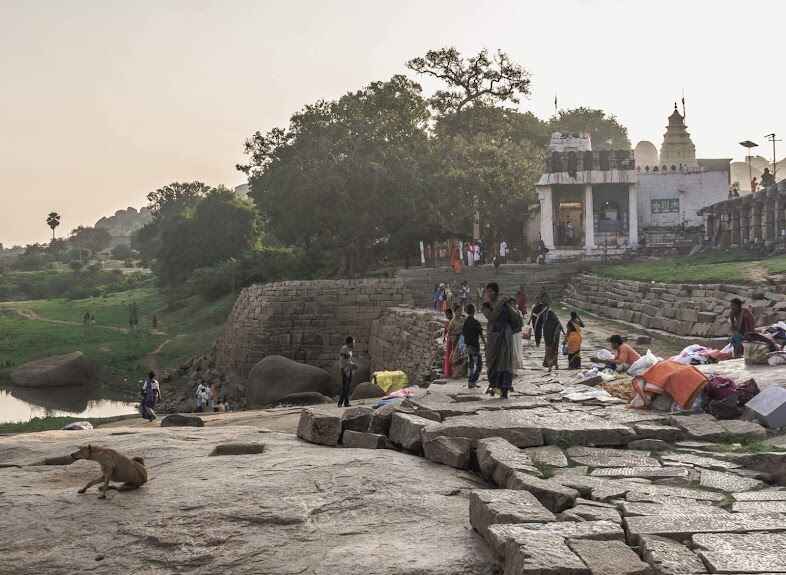
Must-see attractions at Chakratirtha
Chakratirtha in Hampi is not only known for its spiritual significance but also for its natural beauty and historical charm. Here are some of the must-see attractions that you shouldn’t miss when visiting Chakratirtha:
Sacred Whirlpool and Tungabhadra River:
The main attraction of Chakratirtha is the sacred whirlpool formed by the currents of the Tungabhadra River. Take a moment to witness the swirling waters and contemplate the divine associations it holds. The picturesque river itself, with its serene flow and surrounding landscapes, offers a tranquil and scenic experience.
Kodanda Rama Temple:
Visit the temple dedicated to Lord Rama, situated on the right bank of the river near Chakratirtha. Admire the intricate carvings of Rama, Sita, Lakshmana, and Hanuman on a large boulder inside the temple. Take part in the rituals and seek blessings from the deities to enhance your spiritual journey.
Ancient Pavilions and Resting Places:
Explore the ancient pavilions located next to the Kodanda Rama Temple. These pavilions have served as resting places for pilgrims for centuries. Take a moment to relax and soak in the historical ambiance, imagining the pilgrims who have sought solace in these very spots throughout time.
Yantrodhara Anjaneya Temple:
After your visit to Chakratirtha, make sure to visit the nearby Yantrodhara Anjaneya Temple. The inner sanctum of the Yantrodharaka Hanuman temple contains an image of Lord Hanuman enclosed within a hexagonal amulet, depicted in a meditative state. This temple is believed to have mystical powers and is revered by devotees. Pay your respects and experience the spiritual energy within its sacred walls.
Carvings on the Rock:
At the riverbank of Chakratirtha, you will find a large flat rock adorned with carvings. Marvel at the intricate Shiva Lingas and circular patterns depicting footprints on the rock’s surface. These carvings hold immense religious significance and provide a unique glimpse into the ancient art and culture of the region.
Natural Beauty and Serenity:
Take a moment to immerse yourself in the natural beauty that surrounds Chakratirtha. Enjoy the lush greenery, tranquil hills, and the soothing sound of the flowing river. The peaceful ambiance offers a perfect setting for meditation, introspection, or simply appreciating the tranquility of nature.
Coracle Rides and River Exploration:
If weather conditions permit, indulge in a coracle ride along the Tungabhadra River. These traditional round boats offer a unique way to explore the river and its surroundings. Enjoy the gentle sway of the coracle, the refreshing breeze, and the stunning vistas that unfold along the riverbank.
Ancient Ruins:
Wander through the nearby ancient ruins and marvel at the architectural wonders of the Vijayanagara Empire.
Sunrise and Sunset Views:
Capture stunning views of the sunrise and sunset over the river. The changing colors of the sky create a mesmerizing spectacle against the backdrop of Hampi’s ancient ruins.
Kampabhupa Pathway:
Embark on a historical walk along the Kampabhupa Pathway, an ancient route that once connected the Hampi Bazaar with the Vittala Temple complex. This path offers a glimpse into the city’s layout and provides opportunities to discover hidden ruins and serene bathing ghats.
Tips for visitors in Chakratirtha
Explore Chakratirtha and its surrounding attractions with these helpful tips for a safe and enjoyable visit.
- Stay Hydrated: Hampi can get hot, especially during the summer months. Carry plenty of water to stay hydrated while exploring Chakratirtha and its surroundings.
- Watch Your Steps: Some areas around Chakratirtha may have uneven terrain or loose rocks. Watch your step to avoid tripping or slipping, especially near the riverbank.
- Footwear: Wear sturdy shoes as the terrain around Chakratirtha can be uneven and rocky.
- Stay Safe Near the River: The Tungabhadra River can have strong currents, especially during the monsoon season. Avoid swimming in the river and be cautious when walking near the water’s edge.
- Check Weather Conditions: Weather in Hampi can be unpredictable. Check the weather forecast before your visit and be prepared for changes in temperature or rain.
- Use Sun Protection: Protect yourself from the sun by wearing sunscreen, a hat, and sunglasses. Seek shade when necessary, especially during the hottest part of the day.
- Plan Your Visit: Chakratirtha and the surrounding attractions in Hampi can take a full day to explore. Plan your visit accordingly and allocate enough time to see everything you want to see.
- Respect Nature: Hampi is known for its natural beauty, including the Tungabhadra River and surrounding landscapes. Help preserve the environment by disposing of trash properly and avoiding damage to plants and wildlife.
- Photography: Capture the beauty of the swirling waters, the intricate carvings on the rock, and the serene atmosphere.
- Hire a Guide: Consider hiring a local guide to gain deeper insights into the history, mythology, and religious significance of Chakratirtha.
- Carry Cash: While some vendors might accept digital payments, it’s always good to carry cash for smaller purchases.
Gallery:-
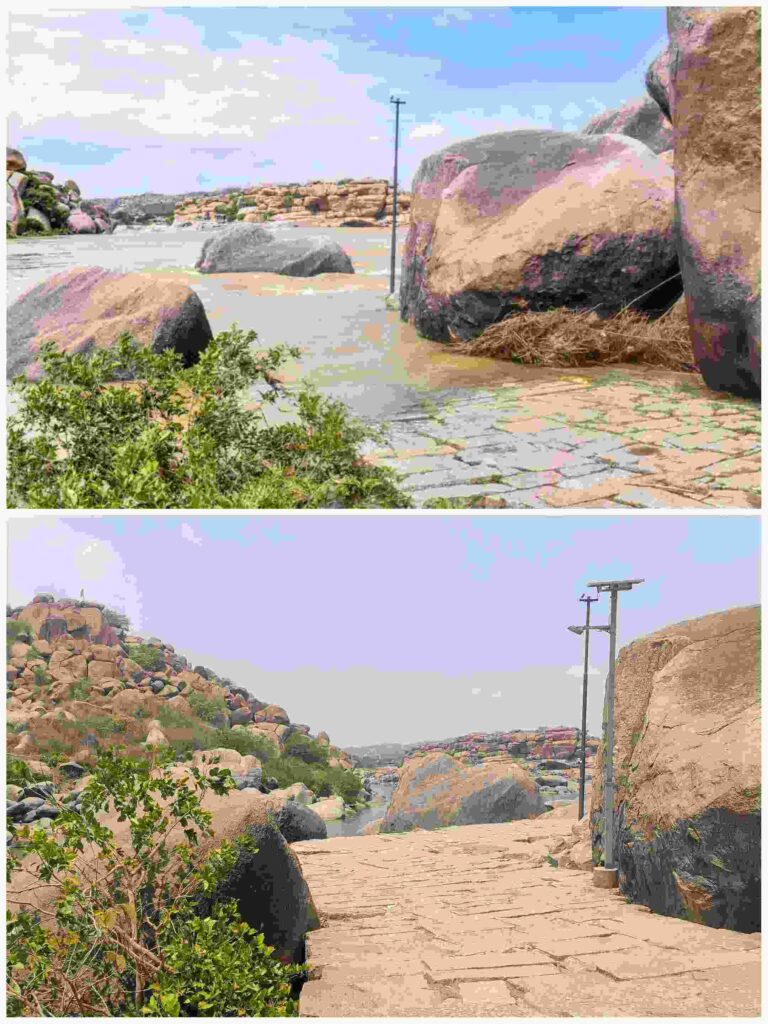
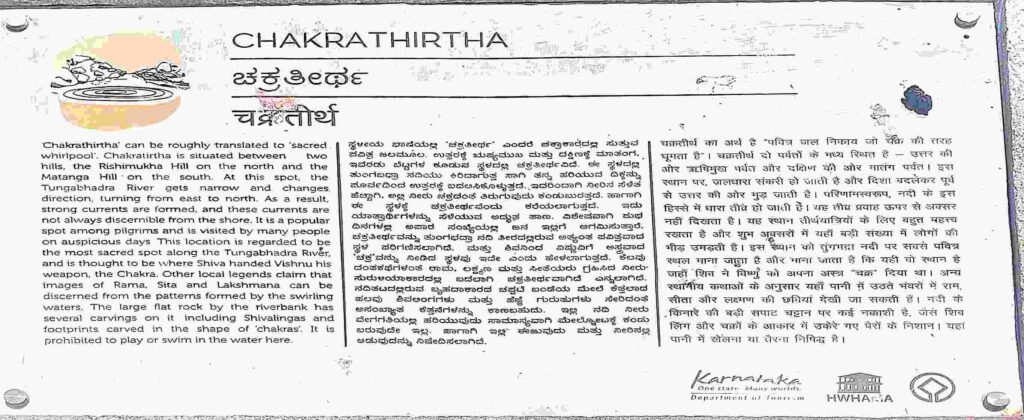
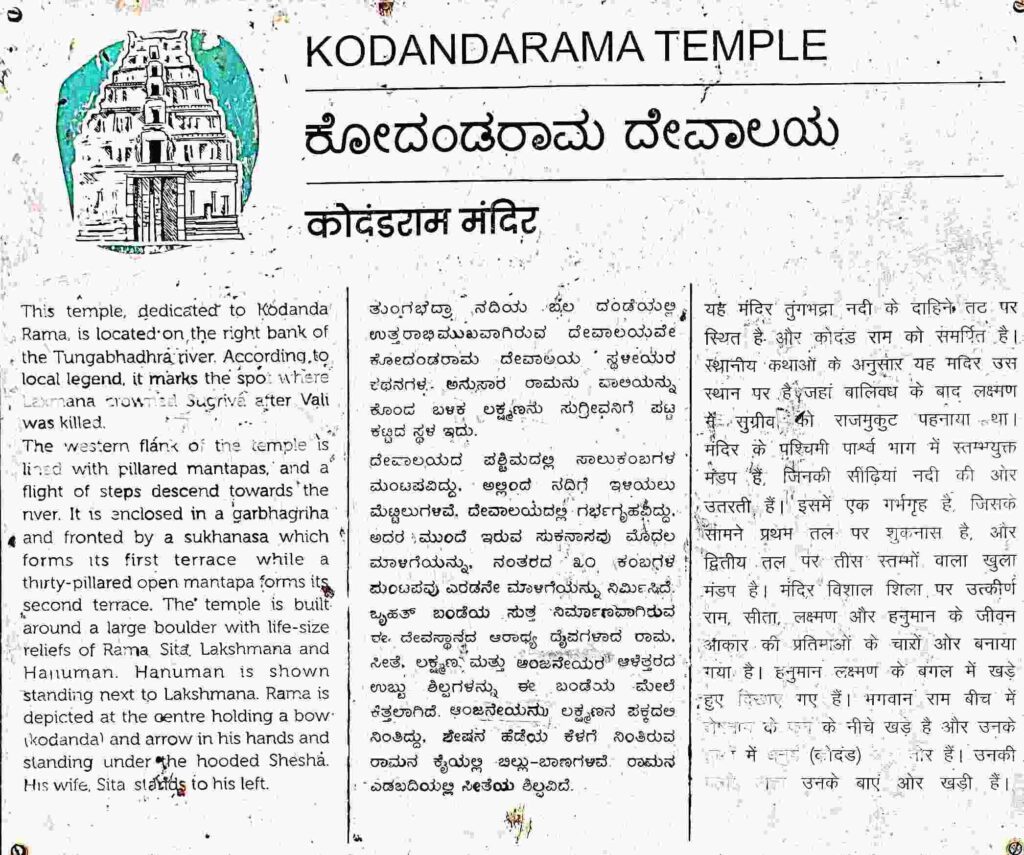
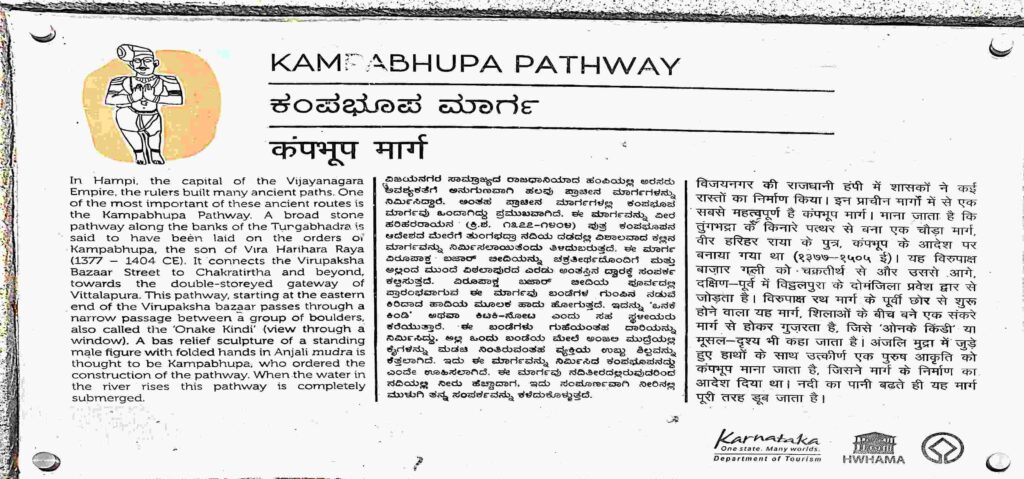
References:-
References from the Following Sources;
- ^[1] – The information about Chakratirtha was sourced from the ASI Information plaque located at the Chakratirtha.
- ^[2] – The information about Kodandarama Temple was sourced from the ASI Information plaque located at the Temple.
- ^[3] – The information about Kampabhupa Pathway was sourced from the ASI Information plaque located at the Kampabhupa Pathway.